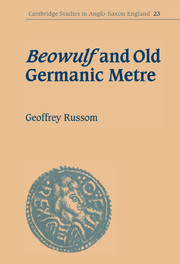Book contents
- Frontmatter
- Contents
- Preface
- List of abbreviation
- 1 Introduction
- 2 The foot
- 3 The verse
- 4 Light feet and extrametrical words
- 5 Metrical archaisms
- 6 Alliteration
- 7 Metrical subordination within the foot
- 8 Resolution
- 9 Word order and stress within the clause
- 10 Old Saxon alliterative verse
- 11 Hildebrandslied
- 12 Conclusions
- Appendix: Rule summary
- Bibliography
- Index
- Verses specially discussed
1 - Introduction
Published online by Cambridge University Press: 02 November 2009
- Frontmatter
- Contents
- Preface
- List of abbreviation
- 1 Introduction
- 2 The foot
- 3 The verse
- 4 Light feet and extrametrical words
- 5 Metrical archaisms
- 6 Alliteration
- 7 Metrical subordination within the foot
- 8 Resolution
- 9 Word order and stress within the clause
- 10 Old Saxon alliterative verse
- 11 Hildebrandslied
- 12 Conclusions
- Appendix: Rule summary
- Bibliography
- Index
- Verses specially discussed
Summary
The author of Beowulf composed in an ancient verse form also inherited by Scandinavian and continental West Germanic poets. The oldest surviving line in this form illustrates its essential features:
(1) ekhlewagastiR : holtijaR : horna : tawido :
Line (1) was carved in runes on a golden drinking horn. The character R represents a sound derived from Germanic z that had not yet merged with r. The language is probably an early form of Norse, and the artefact dates from about 400 AD. Like the lines employed in Beowulf line (1) falls into two natural syntactic constituents of about the same size. The first constituent, a grammatical subject, contains a personal pronoun and two proper nouns. The second constituent, a grammatical predicate, contains a noun object and a finite verb. Word order is SOV (subject–object–verb), generally regarded as the basic pattern for early Germanic. Each half of the line includes two stressed words separated by a boundary marker, indicated above by a colon. No punctuation appears between the unstressed pronoun ek and the first stressed word. The stressed nouns in the first half of the line both begin with H- and are said to alliterate. These two words also alliterate with borna in the second half of the line.
- Type
- Chapter
- Information
- Beowulf and Old Germanic Metre , pp. 1 - 12Publisher: Cambridge University PressPrint publication year: 1998



